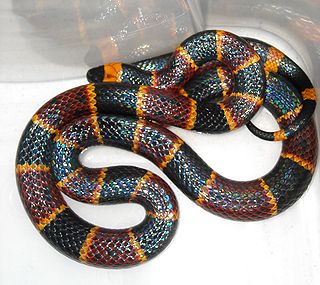
Pituophis is a genus of nonvenomous colubrid snakes commonly referred to as gopher snakes, pine snakes, and bullsnakes, which are endemic to North America.

Heterodon is a genus of harmless colubrid snakes endemic to North America. They are stout with upturned snouts and are perhaps best known for their characteristic threat displays. Three species are currently recognized. Members of the genus are commonly known as hog-nosed snakes, North American hog-nosed snakes, and sometimes puff adders.

Pituophis catenifer affinis, commonly known as the Sonoran gopher snake, is a nonvenomous subspecies of colubrid that is endemic to the southwestern United States. It is one of six recognized subspecies of the gopher snake, Pituophis catenifer.

Ficimia streckeri, commonly known as the Mexican hooknose snake or Tamaulipan hooknose snake, is a small species of colubrid snake. It is endemic to northeastern Mexico and the adjacent southwestern United States.

Rhinocheilus lecontei tessellatus is a subspecies of nonvenomous colubrid snake, which is endemic to the western United States and northern Mexico.

The smooth earth snake is a species of nonvenomous natricine colubrid snake native to the eastern half of the United States. It is monotypic in the genus Virginia.
In snakes and amphibians, the canthus, canthal ridge or canthus rostralis, is the angle between the flat crown of the head and the side of the head between the eye and the snout, or more specifically, between the supraocular scale and the rostral scale. It is defined as a sharp ridge in many viperids, but is rounded in most rattlesnakes, for example.
The labial scales are the scales of snakes and other scaled reptiles that border the mouth opening. These do not include the median scales on the upper and lower jaws. The term labial originates from Labium, which refers to any lip-like structure. In snakes, there are two different types of labial scales: supralabials and sublabials. The numbers of these scales present, and sometimes the shapes and sizes, are some of many characteristics used to differentiate species from one another.
The mental scale, or mental, in snakes and other scaled reptiles refers to the median plate on the tip of the lower jaw. It is a triangular scale that corresponds to the rostral of the upper jaw. The reference to the term 'mental' comes from the mental nerve which addresses the chin and lower jaw in animals. In snakes, the shape and size of this scale is sometimes one of the characteristics used to differentiate species from one another.

Crotalus oreganus abyssus is a venomous pit viper subspecies found only in the U.S. states of Arizona and Utah.
In reptiles, the supralabial scales, also called upper-labials, are those scales that border the mouth opening along the upper jaw. They do not include the median scale. The term labial originates from Labium, which refers to any lip-like structure. The numbers of these scales present, and sometimes the shapes and sizes, are some of many characteristics used to differentiate species from one another.
In reptiles, the sublabial scales, also called lower-labials or infralabials, are those scales that border the mouth opening along the lower jaw. They do not include the median scale. The term labial originates from labium, which refers to any lip-like structure. The numbers of these scales present, and sometimes the shapes and sizes, are some of many characteristics used to differentiate species from one another.

In snakes, the anal scale is the scale just in front of and covering the cloacal opening. This scale can be either single or paired. When paired, the division is oblique. The anal scale is preceded by the ventral scales and followed by the subcaudal scales.

Micrurus fulvius, commonly known as the eastern coral snake, common coral snake, American cobra, and more, is a species of highly venomous coral snake in the family Elapidae. The species is endemic to the southeastern United States. It should not be confused with the scarlet snake or scarlet kingsnake, which are harmless mimics. No subspecies are currently recognized.

Pituophis melanoleucus, commonly known as the pine snake, is a species of nonvenomous snake in the family Colubridae. The species is endemic to the southeastern United States. Three subspecies are currently recognized as being valid.

Chionactis palarostris, commonly known as the Sonoran shovelnose snake, is a species of small nonvenomous colubrid which is a native of the Sonoran Desert in North America. It is one of only two species in the genus Chionactis.
Atractaspis aterrima, commonly known as the slender burrowing asp or mole viper, is a species of fossorial, venomous snake in the family Atractaspididae. The specific epithet, aterrima, meaning "blackest", is the superlative form of the Latin adjective ater, meaning "black".

The midwestern worm snake, Carphophis amoenus helenae, a subspecies of C. amoenus, is a nonvenomous snake in the family Colubridae. The subspecies is endemic to the Midwest and Southern United States.

Phyllorhynchus is a genus of snakes in the family Colubridae. The genus is endemic to the southwestern United States and northwestern Mexico














